(±)-Nornicotine
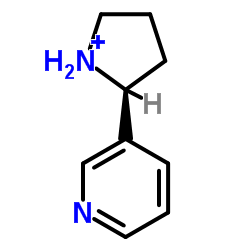
(±)-Nornicotine structure
|
Common Name | (±)-Nornicotine | ||
|---|---|---|---|---|
| CAS Number | 5746-86-1 | Molecular Weight | 148.20500 | |
| Density | 1,074 g/cm3 | Boiling Point | 107-108°C 2mm | |
| Molecular Formula | C9H12N2 | Melting Point | N/A | |
| MSDS | Chinese USA | Flash Point | 101°C | |
| Symbol |

GHS07 |
Signal Word | Warning | |
| Name | 3-(2-Pyrrolidinyl)pyridine |
|---|---|
| Synonym | More Synonyms |
| Description | |
|---|---|
| Target |
Human Endogenous Metabolite |
| Density | 1,074 g/cm3 |
|---|---|
| Boiling Point | 107-108°C 2mm |
| Molecular Formula | C9H12N2 |
| Molecular Weight | 148.20500 |
| Flash Point | 101°C |
| Exact Mass | 148.10000 |
| PSA | 24.92000 |
| LogP | 1.83490 |
| Index of Refraction | 1.54 |
| Storage condition | 2-8°C |
| Water Solubility | H2O: 50 mg/mL |
|
Material Safety Data Sheet
Section1. Identification of the substance Product Name: 3-(Pyrrolidin-2-yl)pyridine Synonyms:DL-Nornicotine Section2. Hazards identification Harmful by inhalation, in contact with skin, and if swallowed. H331:Toxic if inhaled
H302:Harmful if swallowed H312:Harmful in contact with skin H315:Causes skin irritation H319:Causes serious eye irritation P261:Avoid breathing dust/fume/gas/mist/vapours/spray P280:Wear protective gloves/protective clothing/eye protection/face protection P305+P351+P338: IF IN EYES: Rinse cautiously with water for several minutes. Remove contact lenses if present and easy to do – continue rinsing IF INHALED: Remove victim to fresh air and keep at rest in a position comfortable for breathing P304+P340: P405:Store locked up Section3. Composition/information on ingredients. Ingredient name:3-(Pyrrolidin-2-yl)pyridine CAS number:5746-86-1 Section4. First aid measures Immediately wash skin with copious amounts of water for at least 15 minutes while removing Skin contact: contaminated clothing and shoes. If irritation persists, seek medical attention. Eye contact:Immediately wash skin with copious amounts of water for at least 15 minutes. Assure adequate flushing of the eyes by separating the eyelids with fingers. If irritation persists, seek medical attention. Inhalation:Remove to fresh air. In severe cases or if symptoms persist, seek medical attention. Ingestion:Wash out mouth with copious amounts of water for at least 15 minutes. Seek medical attention. Section5. Fire fighting measures In the event of a fire involving this material, alone or in combination with other materials, use dry powder or carbon dioxide extinguishers. Protective clothing and self-contained breathing apparatus should be worn. Section6. Accidental release measures Personal precautions: Wear suitable personal protective equipment which performs satisfactorily and meets local/state/national standards. Respiratory precaution:Wear approved mask/respirator Hand precaution:Wear suitable gloves/gauntlets Skin protection:Wear suitable protective clothing Eye protection:Wear suitable eye protection Methods for cleaning up: Mix with sand or similar inert absorbent material, sweep up and keep in a tightly closed container for disposal. See section 12. Environmental precautions: Do not allow material to enter drains or water courses. Section7. Handling and storage Handling:This product should be handled only by, or under the close supervision of, those properly qualified in the handling and use of potentially hazardous chemicals, who should take into account the fire, health and chemical hazard data given on this sheet. Store in closed vessels, refrigerated. Storage: Section8. Exposure Controls / Personal protection Engineering Controls: Use only in a chemical fume hood. Personal protective equipment: Wear laboratory clothing, chemical-resistant gloves and safety goggles. General hydiene measures: Wash thoroughly after handling. Wash contaminated clothing before reuse. Section9. Physical and chemical properties Appearance:Not specified Boiling point:No data Melting point:No data Flash point:No data Density:No data Molecular formula: C9H12N2 Molecular weight: 148.2 Section10. Stability and reactivity Conditions to avoid: Heat, flames and sparks. Materials to avoid: Oxidizing agents. Possible hazardous combustion products: Carbon monoxide, nitrogen oxides. Section11. Toxicological information No data. Section12. Ecological information No data. Section13. Disposal consideration Arrange disposal as special waste, by licensed disposal company, in consultation with local waste disposal authority, in accordance with national and regional regulations. Section14. Transportation information UN Number:UN2810 Class: 6.1 Packing group: III Proper shipping name: TOXIC, LIQUIDS, ORGANIC, N.O.S. OR TOXIC, LIQUIDS, ORGANIC, N.O.S. INHALA- TION HAZARD, PACKING GROUP I, ZONE A OR B (3-(Pyrrolidin-2-yl)pyridine) Section15. Regulatory information No chemicals in this material are subject to the reporting requirements of SARA Title III, Section 302, or have known CAS numbers that exceed the threshold reporting levels established by SARA Title III, Section 313. SECTION 16 - ADDITIONAL INFORMATION N/A |
CHEMICAL IDENTIFICATION
HEALTH HAZARD DATAACUTE TOXICITY DATA
|
| Symbol |

GHS07 |
|---|---|
| Signal Word | Warning |
| Hazard Statements | H302-H312-H315-H319-H332-H335 |
| Precautionary Statements | P261-P280-P305 + P351 + P338 |
| Personal Protective Equipment | Eyeshields;Faceshields;full-face respirator (US);Gloves;multi-purpose combination respirator cartridge (US);type ABEK (EN14387) respirator filter |
| Hazard Codes | Xn:Harmful; |
| Risk Phrases | R20/21/22;R36/37/38 |
| Safety Phrases | S26-S36/37 |
| RIDADR | 2810 |
| WGK Germany | 3 |
| RTECS | QS6350000 |
| Packaging Group | III |
| Hazard Class | 6.1 |
| HS Code | 2933990090 |
| Precursor 7 | |
|---|---|
| DownStream 9 | |
| HS Code | 2933990090 |
|---|---|
| Summary | 2933990090. heterocyclic compounds with nitrogen hetero-atom(s) only. VAT:17.0%. Tax rebate rate:13.0%. . MFN tariff:6.5%. General tariff:20.0% |
|
6'-Methylpyrido[3,4-b]norhomotropane: synthesis and outstanding potency in relation to the alpha4beta2 nicotinic receptor pharmacophore model.
Bioorg. Med. Chem. Lett. 15 , 877-81, (2005) 6'-Methylpyrido[3,4-b]norhomotropane [synthesis as the racemate reported here] is more potent at the alpha4beta2 nicotinic receptor than any previous bridged nicotinoid. The two nitrogens and 6'-methy... |
|
|
3-(2-Aminoethyl)pyridine analogs as alpha4beta2 nicotinic cholinergic receptor ligands.
Bioorg. Med. Chem. Lett. 15 , 4308-12, (2005) An examination of several 3-(2-aminoethyl)pyridine analogs suggests that they likely orient at alpha4beta2 nicotinic cholinergic receptors in a different fashion than their correspondingly substituted... |
|
|
Abuse potential of non-nicotine tobacco smoke components: acetaldehyde, nornicotine, cotinine, and anabasine.
Nicotine Tob. Res. 15(3) , 622-32, (2013) This review identified published animal studies evaluating the possible abuse potential of acetaldehyde, nornicotine, cotinine, and anabasine based on five commonly used paradigms. These include their... |
| 3-pyrrolidin-2-yl-pyridine |
| EINECS 200-659-6 |
| NORNICOTINE,DL |
| 2-[3-PYRIDYL]PYRROLIDINE |
| (+/-)-nor-nicotine |
| (2S)-2-(3-Pyridinyl)pyrrolidinium |
| 2-(3-pyridyl)pyrollidine |
| MFCD00016913 |
| 2-[3-PYRIDYL]PYRROLIDONE |
| DL-NORNICOTINE |
| 2-(3-Pyridinyl)pyrrolidine |
| (R,S)-NORNICOTINE |
| Pyrrolidinium, 2-(3-pyridinyl)-, (2S)- |
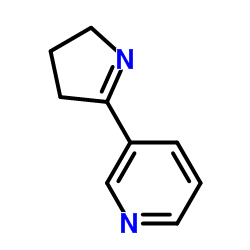 CAS#:532-12-7
CAS#:532-12-7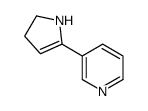 CAS#:1125-96-8
CAS#:1125-96-8![3-[1-(4-toulenesulfonyl)pyrrolidin-2-yl]pyridine Structure](https://image.chemsrc.com/caspic/475/150553-16-5.png) CAS#:150553-16-5
CAS#:150553-16-5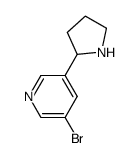 CAS#:71719-06-7
CAS#:71719-06-7 CAS#:88-12-0
CAS#:88-12-0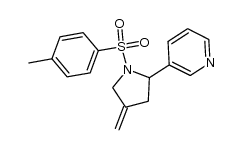 CAS#:150552-88-8
CAS#:150552-88-8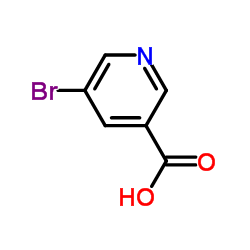 CAS#:20826-04-4
CAS#:20826-04-4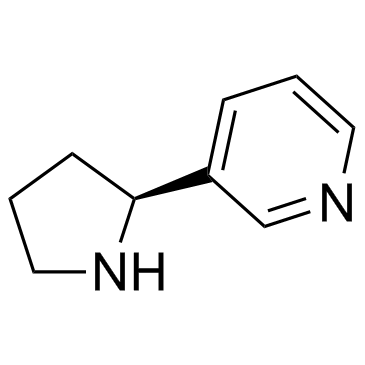 CAS#:494-97-3
CAS#:494-97-3 CAS#:7076-23-5
CAS#:7076-23-5 CAS#:59-67-6
CAS#:59-67-6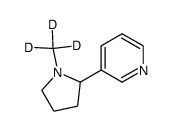 CAS#:69980-24-1
CAS#:69980-24-1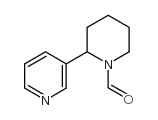 CAS#:3000-81-5
CAS#:3000-81-5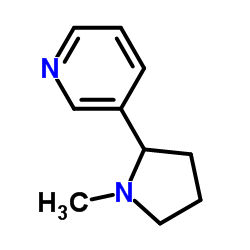 CAS#:22083-74-5
CAS#:22083-74-5 CAS#:54-11-5
CAS#:54-11-5 CAS#:25162-00-9
CAS#:25162-00-9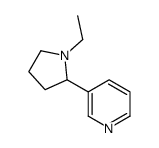 CAS#:86900-39-2
CAS#:86900-39-2
